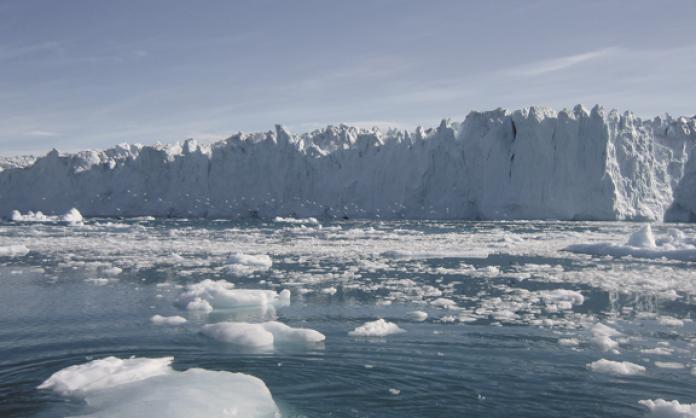The Arctic is melting. In the last week of February, in what should have been among the coldest days of a long, dark winter, the temperature at the North Pole rose above freezing. The Arctic sea ice, which should be expanding south for another month, is already in retreat.
A weather station at Cape Morris Jesup, on the northern tip of Greenland, recorded a temperature of 6 degrees Celsius. That’s 28 degrees above the average for this time of year. It would be like Sydney having a 44 degree day in July.
The Arctic is warming faster than anywhere else in the world. In 2016, the global average temperature was 1 degree Celsius above the long term average. In the Arctic, it was 2 degrees warmer, and the temperature rises are accelerating.
One consequence of this is a rapid reduction in snow and ice coverage. A 2017 report by the Arctic Monitoring and Assessment Programme found that “sea ice thickness in the central Arctic Ocean declined by 65 percent over the period 1975-2012”.
It’s a vicious cycle. Snow and ice reflect much of the sun’s heat back into space. The more the frozen desert of white retreats, the more the ocean and land revealed beneath absorb heat, which drives further melting. If current trends continue, the Arctic Ocean will be ice free in summer by the late 2030s.
This isn’t just a problem for Arctic ecosystems or the people who depend directly on them. The less obvious global impacts are alarming.
One of the immediate threats is the further destabilisation of global weather patterns. Conditions in the Arctic impact the weather across Europe and North America – even as far south as the Indian monsoon.
The current heatwave in the Arctic has come with extremely cold temperatures across Europe. Temperatures in Italy have reached 17 degrees below normal. And for a couple of days, the maximum temperature at the North Pole exceeded that recorded in Zurich, Switzerland.
Climate change isn’t a matter of gradual, steady warming. The warming trend creates instability in the atmosphere, which drives an increase in weather extremes. That’s why we can see record warmth in the Arctic accompanied by colder than average temperatures elsewhere.
This is putting a massive strain on ecosystems. In Australia, the clearest example is the Great Barrier Reef, which is being killed off by coral bleaching caused by warming ocean temperatures and acidity.
One aspect of climate change that’s little understood is the potential to reach “tipping points” where incremental temperature increases result in sudden, dramatic shifts in weather and other environmental processes. The extreme weather in the Arctic may signal the beginning of such a shift.
When facing the prospect of a potentially planetary scale disaster, the logical thing to do would be to address the issue that’s causing it. But that’s not happening.
In late April last year, US president Donald Trump signed an executive order to “unleash American energy” by getting rid of restrictions on oil drilling in the Arctic and Atlantic oceans. And in December, the US Senate authorised drilling in the Arctic National Wildlife Refuge in northern Alaska.
Other global leaders, like Canada’s Justin Trudeau and Malcolm Turnbull, may know how to talk the talk on climate change, but in reality they’re just as committed to fossil fuels as Trump.
Trudeau has pushed to expand oil production from the heavily polluting Alberta tar sands. As recently reported in the Guardian, government documents show that, behind closed doors, Trudeau welcomed the election of Donald Trump, as it cleared the path to approval of the Keystone XL pipeline through the US.
Turnbull may as well be called “captain coal”. He’s doing everything in his power to help open up the giant coal reserves in Queensland’s Carmichael Basin to mining by Adani and other companies.
We’re told that climate change is so complex that it’s too difficult for mere mortals to understand. That is bullshit. Climate change is a problem only because many companies profit from polluting.
There’s a very simple fix. The technology already exists to drive a rapid shift to a 100 percent renewable global energy system. A 2011 study by the World Wide Fund for Nature found that it could be achieved by 2050 for an investment of no more than US$4 trillion a year.
A lot of money, it’s true, but given the situation, it would be worth the price. We could start by recouping some of the US$21 to US$32 trillion that the Tax Justice Network estimates the world’s super rich have stashed away in tax havens. Perhaps we could also reduce the US$1.7 trillion spent globally on the military every year.
The real problem is the existence of a global capitalist class and its paid political lackeys, who are determined, against all evidence and at whatever cost, to persist with the status quo.
To transition to renewables, we also need to transition to a different sort of society – one which values human need above corporate profit.











